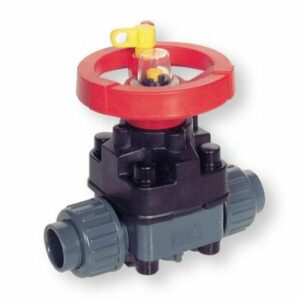Manual Diaphragm Valve
NTGD Valve is professional manual diaphragm valve manufacturer, we can offer high quality diaphragm valve with fast delivery time.
What is a manual diaphragm valve?
A manual diaphragm valve is a diaphragm valve that is operated using a handwheel. The use of the handwheel is to help the valve operator apply the torque needed to start and stop the valve. A manual diaphragm valve operates by using a diaphragm component that closes and opens fluid flowing through the valve. Manual diaphragm valves are cheaper compared to other automatic valve types. These valves are recommended for use in moderate pressure and temperature. They are bi-directional valves allowing fluid flow in either direction. These valves are made of various materials depending on the area of application. Manual diaphragm valve manufacturers use strong metallic material such as carbon steel and stainless steel to make these valves. However, some of these valves are made of soft materials like plastics and thus meant for use in low-temperature applications. Manual diaphragm valve manufacturers produce various types of these valves for use in various applications such as water supply, sewage treatment, paper and pulp, and foods among others.

Components of a manual diaphragm valve
Handwheel
This is the part of the manual diaphragm valve on which the operator applies torque to start or stop the valve.
Stem
This is a component that is connected to the handwheel on one end and the other end is connected to a component known as a compressor. The stem is responsible for transmitting the torque that the operator applies on the handwheel to the compressor.
Compressor
The compressor is connected to the stem at one end and the other end is connected to the diaphragm. The work of the compressor is to transmit force to the diaphragm to lift or lower the diaphragm to allow or block fluid flow.
Diaphragm
This is the component of the manual diaphragm valve that is connected to the compressor. The diaphragm works by moving up and down to allow or stop fluid flow respectively.
Bonnet
This is the component of a manual diaphragm valve used to prevent non-wetted parts of the valve such as the stem and compressor. The bonnet is firmly connected to the valve body using bolts and nuts and or by use of screw threads.
Valve body
The body is used to house internal parts of the valve like the diaphragm and seats. It also contains the valve inlet and outlet ports. Manual diaphragm valve manufacturers design the body using strong materials such as carbon steel, carbon steel, and ductile iron among others. Such materials help to enhance valve strength against impact damage and fluid pressure.
Seat
This is a component inside the manual diaphragm valve where the diaphragm rests on to provide a tight seal free from leakage.
Valve indicators
These are components used in manual diaphragm valves to help the valve operator know when opening or closing the valve.
Gasket
This is a component placed between the valve and the pipe to help prevent fluid leakage. The gasket is held in position by use of bolts that tighten the connection.

How does a manual diaphragm valve work?
A manual diaphragm valve operates by application of torque by the operator on the handwheel. When the torque is applied to the handwheel, it makes the stem that is connected to the handwheel start rotating as it moves either upwards or downwards depending on the direction of rotation. To allow fluid flow through the valve, the handwheel is rotated in the clockwise direction. This makes the stem and compressor move upwards. Since the diaphragm is connected to the compressor, it also moves upwards. This leaves the valve open for the media to flow through. To close the valve, the handwheel is rotated in the anticlockwise direction which forces the diaphragm downwards to create a tight seal with the valve body. This tight seal prevents fluid from flowing through the valve. For throttling use, the handwheel is rotated slightly allowing some amount of fluid to flow through the valve.

Types of Manual diaphragm valves
Straight through manual diaphragm valve
This is a manual diaphragm valve that has a flat bottom body. This design helps to reduce chances of media obstruction along the flow path. Manual diaphragm valve manufacturers design this valve such that it closes once the diaphragm touches the bottom most part of the body. As such, this type of valve is made using a diaphragm from flexible materials. However, the diaphragm on this valve is usually replaced frequently because of the frequent wear. This valve is best for handling any sort of media from semi-solids, sludge, slurries, and even very viscous fluids. This property is enhanced by the fact that there is no saddle common in other valves to obstruct media flow.
Figure: Straight through manual diaphragm valve.
Weir-type manual diaphragm valve
Weir type manual diaphragm valve is the most common type. This valve is designed for leak-proof flow controls. Manual diaphragm valve manufacturers design this valve with a saddle at the valve center. The diaphragm rests on the raised saddle to provide a tight seal against fluid flow. The inclined saddle design is such that fluid can flow in either direction of the valve. This valve is highly recommended for use in hazardous and corrosive media because the bonnet can control diaphragm failure and or any fluid leakage. However, this valve is best for controlling the flow of clean and homogenous liquids since viscous fluids and sludge can collect on the saddle.
Figure: Weir type manual diaphragm valve.
Plastic manual diaphragm valve
This is a manual diaphragm valve that is made of plastic material. This means that the valve body, as well as the valve interior, are made of plastic materials. This valve is advantageous in that it is cheaper compared to metallic ones. Also, this valve is light in weight due to the low density of plastic materials. Plastic materials are excellent in corrosion resistance and thus this valve can be used to control the flow of corrosive media such as acids. However, manual diaphragm valve manufacturers recommend use of this valve only at low temperatures because of poor thermal properties of plastics.
Figure: Plastic manual diaphragm valve.
Zero static manual diaphragm valve
This is a multi-port manual diaphragm valve meant for eliminating dead leg and drainage or process stream stagnation. Manual diaphragm valve manufacturers design this valve to allow fluid transfer, diversion, sampling, and drainage without causing a major impact on systems such as purified water or water for injection. These valves are designed such that the bonnet can allow the weir to be aligned directly on the pipeline’s inner diameter. This helps to reduce dead legs and fluid stagnation and contamination. This valve is commonly used in the pharmaceutical, foods, and beverages industries.
Hygienic manual diaphragm valves
This is a manual diaphragm valve designed with minimal areas where fluid can be obstructed. This valve is meant for handling human consumption products. These valves are mostly used in food and beverage processing plants.
Sanitary manual diaphragm valves
This type of manual diaphragm valve is meant for use in applications that need very clean and pure fluids such as dairy, foods, beverages, winemaking, and pharmaceutical applications. Manual diaphragm valve manufacturers design the valve to enhance the aseptic environment for the media to flow without viruses, fungi, and bacteria thriving. These valves can handle slurries, gaseous, and liquids.
Applications of manual diaphragm valves
- Manual diaphragm valves are used in the foods and beverage processing plants.
- They are used in the municipal water supply.
- They are used in wastewater treatment and transportation.
- Manual diaphragm valves are used in the process of making drugs in the pharmaceutical industry.
- They are used in the process of making different types of chemicals.
- These valves are used in the manufacturing of paper and pulp.
- Manual diaphragm valves are used in the mining industries as they can work on sludge and other semi-solids.
- They are used in the manufacturing of electronics.
- They are used in oil and petroleum supply.
Advantages of manual diaphragm valves
- Manual diaphragm valves are cheaper compared to automatic ones.
- These valves are free from fluid leakage due to the tight seals and especially if used at the recommended pressure level.
- These valves are versatile as they can be used in a wide range of industrial applications.
- These valves are resistant to corrosion.
- Manual diaphragm valves are easy to repair, clean, and do maintenance.
- They are of simple and compact design.
- These valves can be used for on and off as well as throttling applications.
- They can be used in hazardous and radioactive media.
- Manual diaphragm valves allow bi-directional fluid flow.
Disadvantages of manual diaphragm valves
- Manual diaphragm valves are tedious to operate especially where the valve needs a lot of torque and frequent operation.
- These valves are prone to blockage due to the saddle on the flow path.
- They tend to lower hydrostatic pressure.
- They are not suitable for use in high pressure and high temperatures.
- The diaphragm component erodes when used frequently in extensive throttling applications.
Troubleshooting manual diaphragm valve
Diaphragm rupture
- The diaphragm is aging. Replace the diaphragm.
- High operating pressure. Ensure the fluid pressure level is the one recommended by the manual diaphragm valve manufacturer or use a valve with high operating pressure.
- Foreign materials clogged between the valve seat and diaphragm. Open the valve according to the manual diaphragm valve manufacturer’s instructions and remove foreign materials.
- Excessive opening height of the valve. Ensure the recommended opening height is not exceeded.
Fluid flow while the valve is closed
- The diaphragm or valve seat is scratched. Replace the diaphragm or seat as necessary.
- Foreign materials inside the valve. Remove foreign materials.
The manual diaphragm valve cannot be opened fully
- Broken compressor pin. Replace the compressor pin.
- Dirt clogged inside the valve. Clean off the dirt.
The handwheel is rotates but the valve does not operate
- Broken stem. Replace the stem.
- Broken compressor pin. Replace the pin.
Fluid leakage between the bonnet and the body
- Loose bolts. Tighten the bolts to the torque instructed by the manual diaphragm valve manufacturer.
- Worn out seals. Replace the seals.
Leakage between the body and pipe connection
- Loose connection. Tighten the connecting bolts to the torque instructed by the manual diaphragm valve manufacturer.
- Worn out gasket. Replace the gasket.
- Worn out seals. Replace the seals.
Summary
A manual diaphragm valve is a type of diaphragm valve that is only operated by applying torque on the handwheel. This type of valve is cheaper relative to the automatic types. The valve operates when the valve operator applies a torque on the handwheel to either start or stop fluid flow. The start of fluid flow through a manual diaphragm valve starts when the handwheel is rotated in the clockwise direction forcing the stem and compressor to move upwards. This then forces the diaphragm to move upwards and this leaves the valve open for fluid to flow. To stop the valve, the handwheel is then rotated in the anticlockwise direction forcing the diaphragm to create a tight seal with the body and thus blocking any fluid flow.
Manual diaphragm valve manufacturers produce various types of these valves which include straight-through manual diaphragm valves, weir type manual diaphragm valves, plastic manual diaphragm valves, sanitary manual diaphragm valves, and hygienic manual diaphragm valves among others. Applications of these valves include foods and beverages, chemical processing, paper and pulp, pharmaceuticals, and water supply among others. Advantages of using a manual diaphragm valve are simple and compact design, cheaper, easy to clean and repair, versatile, free from leakage, and bi-directional fluid flow.



